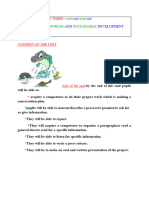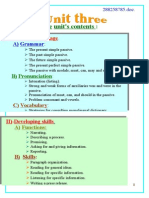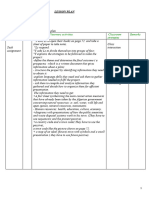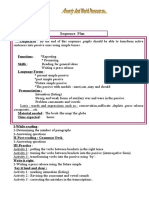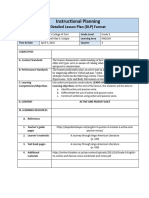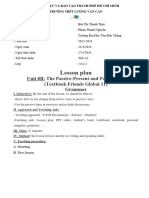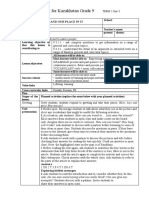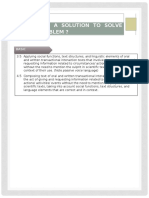0 ratings0% found this document useful (0 votes)
112 views29 pagesUnit 3 Waste Not Want Not 2as
Uploaded by
wahibasaadhellalCopyright
© © All Rights Reserved
We take content rights seriously. If you suspect this is your content, claim it here.
Available Formats
Download as PDF or read online on Scribd
0 ratings0% found this document useful (0 votes)
112 views29 pagesUnit 3 Waste Not Want Not 2as
Uploaded by
wahibasaadhellalCopyright
© © All Rights Reserved
We take content rights seriously. If you suspect this is your content, claim it here.
Available Formats
Download as PDF or read online on Scribd
You are on page 1/ 29
UNIT THREE: WASTE NOT WANT NOT
WORLD RESOURCES AND SUSTAINABLE DEVELOPMENT
CONTENT OF THE UNIT
».
ee
AIM OF THE UNIT:by the end of this unit
Pupils will be able to:
* acquire a competence to do their project work which is making a
conversation plan.
*pupils will be able to narrate/describe a process/to promise/to ask for
or give information.
*They will be able to report.
*They will acquire a competence to organize a paragraph,to read a
general idea/to read for a specific information.
*They will be able to listen for specific information.
*They will be able to write a press release.
*They will be to make an oral and written presentation of the project.
Dirah high school
Academic year : 2012-2013 Unit 04: Waste not want not
Level : 24 year Sequence: Discover the language
Text book:Getting through Lesson:before/As you read
Learning objectives: pupils will be abel to:
recognize the main topic and check their knowledge through looking to the picture
and answer some questions related to it.
look for specific and accurate details in texts.
Competencies:
interactive: interacting and comenting
Interpretive: interpreting the picture (reading a map), pupils will read the text silently
and then interpreting its ideas by answering some questions. (interpreting the text’s
ideas)
Teaching Aids: the text book (Getting through).
Exira resources: the world map/pictures
Rubrics Lesson Plan Aims: TA
Preview page 59 | Athe teacher and students discuss the “to familiarize
content of the unit,including the new unit __ pupils with the
project theme,and how it could be realized. | topic and the
project
15
to recognize both | mn
the main topic
and the language
components used
in this unit
‘Think it over p59 | A the teacher provides pupils with a correct
words to say: __ | reading of the words,each time the teacher
reads a word,pupils repeat imitating
therefore the pronunciation.
Before you read | A Teacher introduces the lesson by asking
students questions about the map.
Pupils answer each question depending on
their geographical culture and their
imagination.
al To motivate
1) The map represents Southern students and to 1s
America. check their
background mn
2) The area in green stands for the
Amazon forest.
3) Itis situated between Brazil,
Peru,Ecuador and Bolivia.
knowledge
‘As you read
page 60
4) ‘The equatorial climate is hot and
humid.
5) The line is that of Equator.
‘Task 1: this task has the same answers as
the previous questions.
‘Tasle 25 answer the following questions.
~Students read the text silently then the
teacher holds a short discussion about the
main ideas of the teacher.
Key:
1) There is more than a decade of
global fossil fuel emissions of carbon
dioxide stored in the Amazon forest
trees.
2) The Amazon basin ecosystem has
been protected from the threats
because of its isolation.
3)It is one of the world’s greatest
conservation challenges because it is no
longer isolated.
-To check
students
understanding
and compare their
answers with their
previous ones.
-To enable
students to read
for specific
information.
10
mn
30
mn
Dirah high school
Academic year : 2012-2013 Unit 03: wast not want not
Level : 24 year Sequence: Discovering language
Text book:Getting through Lesson 02:Grammar desk
Learning objectives: pupils will be able to :
“best use and learn how to construct the active and the passive voice and for which
purpose is formed :past simple passive, future,present perfect and modals
Competencies :
interpretive: pupils will analyse and synthesis examples of passive and active .
Linguistic :they consider some examples, ,at last they draw rules.
productive:pupils will produce a short passage using the passive voice.
Teaching Aids: the text book (Getting through).
Extra resources: handouts of active and passive .
Rubrics Lesson Plan Aims TA
Warming | #the teacher asks the pupils to give him a -to motivate pupils
up sentence which contain a: subject + verb and drawtheir
object. attention to the
Pupils will give different sentences . coming step
The teacher writes one on the board 1omn
e.g: Ahmed_eats_an apple.
s vo
the teacher asks his pupils to start the
sentence with the object.
*An apple is eaten by Ahmed (passive)
“the teacher makes clear to the pupils the
difference between the active and the passive .
After
Reading | ATTeacher asks pupils to answer the
Page61 questions in the grammar desk to make them
distinguish between the two types of
sentences. To focus on the use
-Motivate pupils to compare sentences (A) _| of the passive and
and (B). active form.
'A) Timber companies fell the trees. ~ To give students
B) The Brazilian government built new _| the competence to
roads in Amazon. recognize the tenses
- These sentences are in the passive voice of the sentences.
because the subjects of the verbs are not really
doers of the actions.
- The sentences focus is on the action rather
than on the doers/ performers.
a) Timber companies fell 18000 km2 of the
forest trees.
b) The Brazilian government built new
roads throughout the 1960’s and 1970's.
3) Comparing between the sentences:
- The sentences that give attention to the
action itself are the sentences from the
reading passage (passive voice).
~The student’s sentences are in the active
form, they put emphasis on the doers of the
actions.
4)The writer has inverted the structure by
foregrounding the action (putting it first in the
sentence structure) and putting the doers
(subjects) of the action at the end of the
action.
5) Match sentences a-d with the appropriate
tenses:
A>C (Present simple passive).
BD _ (Past simple passive).
CB (Present perfect passive).
DA (Future simple passive).
6) Read sentences again, is it always necessary .,
to use “by”? -to check the pupil's
comprehension and
-No it is not always necessary to use “by” in nprehension
their writing skills.
the passive sentence.
-We use it when we want to draw attention to
the doer of the action.
Production: Bab el ouad flood is one of the
natural disasters witnessed in Algeria.
Ina brief and concise passage talk about its
bad results using the passive voice.
Use the following notes:
*many people /killed
*homes /ruined /lost
*vietims /lost .
*trees_/destroyed.
35mn
15mn
Pupils work in groups,and then the teacher
correct and choose the most convenient
passage and writes it on the board.
Academic year : 2012-2013
Level : 24 year
Text book:Getting through
Dirah high school
Unit03: wast not want not
Sequence: Discover the language
Learning objectives: pupils will be able to:
#acquire the competences of conjugating verbs using simple past passive.
4To pronounce ‘was’ and ‘were’ correctly in a passive oral-read sentence.
Competencies:
Lesson03: Practice
interactive/intespretiveroral interaction about prior knowledge.
Lnguistic:pupils explore their knowledge acquired about the passive voice and try to
practise it and find answers to the activities.
Teaching Aids:
the text book (Getting through)
Extra resources: Extra activities about the passive form(handouts)
Rubrics Lesson Plan Aims TA
Warmingup | #The teacher asks pupils about the
language aspects they have learnt in
the previous lesson.
Pupils give their answers.
#The teacher asks pupils to practise | To enable pp’s to use the
the use of simple past passive by doing | past simple passive. 15mn
Practice task 01 page 62.
Page’? 4read the report and put the verbs
ask between brackets into the simple past | "To enable students to
passive. acquire competences to
Key: conjugate verbs in the
-=was wrecked- it was washed simple past active and
-The water was polluted- the beach passive, and be able to
was damaged. The fish industry was _| differentiate between the
ruined. Hotels and restaurants were | two, 15mn
closed. -To focus on the
pronunciation of the
Task2. auxiliaries “was” and
conjugate the verbs between brackets
into the simple past passive. Then
listen to the dialogue and note how
“was” and “were” are pronounced.
“were” (weak/strong
forms)
Task 03
Task4:
Key;
Speaker A; what happened to the
Exxon Valdez?
Speaker B: it was wrecked off the coast
of California and the oil spilled out.
Speaker A:
the oil was washed out onto the beach?
Speaker B: yes it was. “Strong form”.
Speaker A: was the fish poisoned?
Speaker B: yes, they were. “Strong
form”. They were suffocated for lack of
02.
#The teacher asks pupils to act out the
dialogue above (books shut).
Pupils work in pairs.
‘The teacher checks and corrects her
pupils mispronunciation.
4tum sentences A-E below into the
passive form.
Key:
1) Air pollution is caused by fumes
from automobiles exhaust pipes.
2) Many water zones will be
depleted of their oxygen by
pollution soon.
3) Cigarette smoking will be
banned by Algerian government
next year.
4) A lot of environmental stamps
have already been issued by the
post telecommunication
ministry.
5) No drastic limits have been
imposed on gas emission yet.
-To focus on the
pronunciation of “was”
and “were”.
-To enable students to
stimulate the dialogue.
-To enable students to
make transformations
from active to passive
using’ by’.
15mn
15mn
Dirah high school
Academic year : 2012-2013 Unit 03: waste not want not
Level : 24 year Sequence0I: Discover the language
Text book: Getting through Lesson: write it right
Learning objectives: pupils will be able to:
Recognize what a press release is .
4 write a press release using using the future passive.
Competencies:
-interactive:through an oral interaction,pupils will be able to express their opinions
related to press release.
-interpretive: pupils will interpret and analyse pictures to get details.
-productive:pupils will be able to produce a short press release.
Teaching Aids: the text book (Getting through)
Extra resources:datashow,pictures.
Rubrics Lesson Plan Aims
TA
. “the teacher asks pupils to open their books on | -to motivate pupils
Warming up | page 63 and look at the picture and say what it | and introduce the
represents. subject implicitly.
-pupils give their opinions
-the teacher guides and corrects step by step
and draw pupils attention to the subject of the
task.
Task p 63: | «Teacher explains what a press release is?
‘A press releasetis official statement made by
authorised
persons,companies,organizations,political
parties or a government department to be
published in newspapers in order to apologize
and make a particular event less tight.
The teacher asks his learners to read the
question of the task then he explains the - To enable
instructions:imagine that you are the secretary _| Students to write a
in the shipping company,you have to write a press release
press release to apologize for the damage of the
Exxon
15mn
05mn
valdez.
4#The learners work in pairs or in groups .
‘The teacher guides and directs pupils attention
to the given notes in the box to use and also asks
them to use the future passive.
#The teacher chooses the best press release to
be written and corrected on the bb
-Pupils copy down the work on their copy
books.
Sample press releas
We make our sincere apologize for the damage
caused by the wreck of the Exson Valdez
yesterday.oil will be cleaned ,marine life will be
restored, birds will be washed out.We promise
that 2000 workers will be recruited soon.Hotel
workers will be employed by the company and
the tourist industry will be compensated for its
loss.
-To stress on the
use of the passive
voice in the future.
40mn
Dirah high school
Academic year : 2012-2013 Unit 03: waste not want not
Level : 24 year Sequence: Discover the language
Text book: Getting through Lesson 05:Say it loud and clear
Learning objectives: pupils will be able to:
4practise the rising and falling intonation in the spoken or written English.
‘consolidate the correct pronunciation of consonants or vowels.
Competencies:
interactive :pupils interact,discuss, with the teacher through questions .
Linguistic: pupils differentiate between consonants that aren’t easy to pronounce.
Teaching Aids: the text book (Getting through).
Extra resources: dictionaries
Rubrics Lesson Plan Aims TA
Warming up ‘the teacher asks the pupils to mention _| -to motivate pupil’s
the names of their teachers. attention to the 10
* Pupils give their answers,and then asks | coming step mn
them about what they hearwhether they
still wait for the list to be continued or not
and why.
-pupils give their answers.
the teacher introduces the subject of
rising and falling intonation.
Task 1:
-The activity illustrates list intonation, We
Say it Loud and_ | ¥se a falling(|) intonation when we end
Clear the listing and a rising ()intonation when 15
Page 64/65 we are still in the process of doing so. -To enable MN
Key: students to acquire
energies|... -solar}, wind’, biomass} —_a competence to
and hydroelectric resources: the distinguish
wind), the sun}, the between the falling
mountains}.........viable|.Itis cheaper}, | and the rising of
safer}, and less polluting |. i
Biskra}, Djelfa}, Hassi Rimel
Algeria|.
intonation.
Task 3
learners listen then do their work.
The teacher makes the correction
collectively with her learners.
The teacher writes a rule to be followed by
learners .
We use a falling intonation|when we
end the listing and a rising intonation }
when we are still in the process of doing
so.
Teacher discusses with students and tries to
drop out the sounds which do not exist in
their native language.
Key
p-v- Uf- g- d3.
Athe underlined letters in the words below are
mispronounced. Correct the mistakes in the
transcriptions.
Letter: /
Beautiful: /
Burned: /
Were saved: /
Polluted: /
Bird: /
Washe
/
-To enable the
students to find out
the problems of
pronunciation.
-To correct the
common mistakes
of pronouncing
consonants and
vowels
-To enable
students to find the
correct definition
in a dictionary
15
15
MN
Taskl:
Students are asked to look for the words in a
dictionary.
Key: -To identify the
Conserve:. categories of the
Sewage: words.
Deplete:...
Tas!
Teacher teaches the students the strategies for
checking difficult vocabulary. They need to
identify the category of words.
Key:
A> Pronunciation
B Nona
C- Figurative Language
D> Example
E-> Transitional V
E> Something
G> Somebody
H-> Proverb
I> Uncountable
J> Colloquial English
KK American Eng
L= Noun, colloquial eng
15
MN
Dirah high school
Academic year : 2012-2013 Unit03: wast not want not
Level : 24 year Sequence0)2: Developing skills
Text book: Getting through Lesson 01: listening and speaking
Learning objectives: pupils will be able to:
Identify and interpret the photosynthesis process(describing the process).
Realize how modals are pronounced in the passive form
“Describe the process of respiration of plants at night.
Competencies:
Interactive/Interpretive: pupils interact and interpret the picture to get specific details
Productive:pupils will write a short paragraph about the process of respiration in plants
at night by reinvesting pupil’s prior knowledge.
Teaching Aids: the text book (Getting through).
Extra resources:////////
Rubrics, ‘Lesson Plan Aims TA
Warming up | #the teacher asks his learners to open their . ;
books on page 66 and look at the pictures:he | -t0 activate the prior
lets them speak about the “process of knowledge .
photosynthesis” and to mention what they
know.
*pupils present their ideas. | |
*the teacher interacts more with his learners | -te motivate pupils to | 19mn
and try to give a definition of the the coming step. s
word:photosynthesis.
Definition: is the way that green plants make
their food using sunlight.
Task: oo
Page 66 ‘the teacher asks his pupils to look at the
picture and complete the blanks in sentences
from a-e using the correct form of the verbs
nc boee through (from) the
Key picture. 15mn
a) Carbon dioxide is derived from the air. s
To enable students
identify the process
b) Water is drown fro the soil.
c) Sunlight energy is absorbed by the
chlorophyll.
d) Oxygen is released from plants
Task 02
Page 66
¢) Sugar is produced during
photosynthesis.
Pupils copy down in their copybooks.
pupils listen and take notes
*The teacher makes the correction then asks
them to describe the process of
photosynthesis.
*Pupils do their work.
*The teacher asks pupils to report their
answers.
‘the teacher asks his pupils to listen and
note how modals are pronounced. Cross out
the wrong transcriptions?
Key: the correct transcriptions are
-/kaimbit / / Sumbit/
#Tcachcr brainstorms the topic with students
before they describe the process of respiration of
the plant at night.
Learners use their background kowlegde in
Botany to describe this process in class.
Orally,pupils present their work,the teacher
checks and corrects.
-To listen and select
the right
pronunciation.
-To sum up what has
been studied and
check students
understanding of the
photosynthesis
process.
correct,
pronunciation of
modals:must,can’t,sh
ould in the passive
form.
-making an oral
description of a
process.
10mn
10mn
15mn
Dirah high school
Academic year : 2012-2013 Unit03: wast not want not
Level : 2 year Sequence: Discover the language
Text book: Getting through ‘Lesson: your turn
Learning objectivespupils will be able to:
‘tum sentences into the passiveand pay attention to the pronunciation of the modals.
#learn and understand and be aware of the strategies of making a speech delivery.
Competencies:
Interactive/Interpretive:the teacher and pupils interact and interpret the tip box to
get specific knowledge to perform the activities.
linguistic:pupils will practise the passive voice using modals.
Teaching Aidstthe text book (Getting through)
Extra resources:////////
Lesson Plan Aims TA
the teacher asks his learners to open
their books on page 67then turn the _| “To be able to turn
sentences below into the passive. Note | sentences into the
how modals are pronounced? passive,
Key:
1) Animals in danger of extinction 25mns
mustn’t be hunted.
2) Recyclable objects shouldn’t be | -To focus on the
thrown away. pronunciation of
3) Desertification should be modals.
stopped.
4) Pollution can be divided into
four types.
5) Alternative energy may be -making students
grouped in 5 types. aware of the
6) Human resources must be strategies for ideas
protected. organization.
‘The teacher goes through the
tip box with pupils to explain
that when making a speech.
-giving a lecture
-a report.
-a detailed explanation.
Tip Box
We use a number of link words
to organize our ideas and to
make it we say
Some of these discourse markers
are:
Discourse markers:
Eg: first, second.
Next, then......
In addition, moreover, besides...+e.+++.
Lastly, finally, to conclude.........
-enabling pupils
acquire some
linguistic techniques
for an organized
speech message.
Dirah high school
Academic year : 2012-2013 Unit 03: waste not want not
Level : 2 year Sequence02: Discover the language
Text book: Getting through Lesson 02:Waite it up
Learning objectives: pupils will be able to:
explore their newly leamt language forms(passive {and using them in a particular
context(written presentation of the solar home.
Competencies:
Interactive/Interpretive:pupils interact with the teacher and interpret the shown
picture to get specific details about the solar home how it’s made up.
Productive:pupils will write a short presentation of the solar home .
Teaching Aids: the text book (Getting through )
Extra resources://////////
Rubrics Lesson Plan Aims TA
Task1 p 63 Teacher interacts with the students using
the picture.
-Teacher helps the students to identify the
different parts of the solar home. Besides,
teacher explains the difficult vocabulary
items.
-pupils are asked to write a presentation of
the solar home using appropriate link words
from the previous tip box.
-pupils work in pairs /or small groups .
-teacher guides and controls.
-pupils do their work and report their
answers.
E.
-To enable students
to acquire a
competence to
write a speech th
using the link
words mentioned
in the tip box,
focusing on the use
0 the passive voice.
Ladies and gentlemen, this is our new
type of solar home.it’s better than other
homes it’s friendly,it’s totaly operated by solar
energy
during winter, outside air is captured by
warm glass roof panels. Then, warm air is
forced into a water tank by air handling unit.
Next, the water in the tank is heated and
greater quantities of warm water air are
released. The hot air
is then sent down a duct to the crawlspace in
under floor area. After that, warm water rises
through floor registers to the living space.
Some of the heated air is absorbed by
concrete slabs when it is released at night.
This process is reversed during summer.
* Pupils copy down the production on their
copybooks.
Dirah high school
Academic year : 2012-2013 Unit03: wast not want not
Level : 2 year Sequence03: Reading and Writing
Text book: Getting through Lesson0l:
Learning objectives: pupils will be able:
# Read a text to get specific or general information and to enrich their lexical and
grammatical memories.
4 learn how different sentences are joind to organize a well written paragraph.
Competencies:
interpretive:pupils will interpretthe text ideas to get general or specific details.
Interactive:pupils will interact with the teacher through questions.
Productive:pupils will fill in given blanks depending on the understanding of a written
passage
Teaching Aids:the text book (Getting through )
Rubrics Lesson Plan Aims TA
Taskl p 69: | #the picture illustrates a magazine article. | To enable the 10
‘The teacher asks his pupils to Look at students to guess the | mn
them and complete each statement with | answers by looking to _|
the right item (a, b or ¢). the picture.
-pupils do their work.
Key:
1) The ear in picture A is assaulted by
noise.
2) The ear in picture B is wearing a
hearing aid.
3) The topic of the magazine article
will be about noise pollution. -To enable students
Task 2/3p 70 | #the teacher asks his pupils to read the _| acquire a competence
article silently on the previous page again | in finding meaning of
and find the answers for the following? _| words, and distinguish
Key: between: 20
-Easily made angry-> itritability.(noun) | noun/verb/adj
-Is confirmed— is bome out. (verb)
-Related to the brain mental. (adjective)
mn
-To check pupils’s
4the teacher asks his pupils to choose the | understanding of the
best title for the article? justify article.
Task4p 7 Key:
a- Another kind of pollution.
this title is the most appropriate
answer,because pollution can have
different forms and in many
field:air,garbage,and even noise contrary
to what people think that pollution affects
only the climate,seas and oceans.
“The teacher lets the pupils read the tip
box and explains the types of sentences
and their functions in building
paragraphs.
Then,the teacher asks pupils to provide
examples of each type from the previous
text.
Pupils do their work.
Key:
a) A sentence which focuses on the
general ideais:
For a long time, noise has.....physical
disturbance.
b) A sentence which gives details to
support /develop the general idea is;
In Los Angles........airport have.
©) A sentence which provides a smooth
transition from one idea to another is:
In the opinion of many..........unning
out.
d) A sentence which supports the new
ideais:
y three or
e) A sentence which logically concludes
the ideas discussed in the § is:
This health alert...
“To focus on the types
of sentences which
enable students to
write a well organized
paragraph.
10
mn
Dirah high school
Academic year : 2012-2013 Unit 03: waste not want not
Level : 24 year Sequence: Discover the language
Text book: Getting through Lesson02:Write it out
Learning objectives: pupils will be able to:
4give pupils further opportunities to practise the passive voice with longer
sentences:complex ;compound,complex sentences in different tenses and in a given
context.
4know the logical order and organization of sentences in a coherent paragraph.
Competencies:
Interactive/interpretive:pupils will interpretexplore and reinvest their knowledge about
the passive and practise it in longer sentences.
productive:pupils will write acoherent newspaper article about desertification by
ordering sentences.
Teaching Aids:the text book (Getting through)
Extra resources:////////
Rubrics Lesson Plan Aims TA
‘Task Ip71: | # the teacher asks his pupils to open their books
on page 7land do the first activity.
The teacher explains the instruction of the task.
put the verbs between brackets into the correct
form of the passive
Pupils do their work in rough. ‘To focus on the
Key: passive voice with
a) are created- are grazed trampled long sentences in a
b) are denuded certain context.
©) ate introduced-are audged out
@) is caused- are provoked
©) are dissipated-is eroded
£) Was made.
g) Are threatened. 15mns
h) Must be stopped.-will be transformed
i) were built
j) were established.
Task 2p 71;
Sthe teacher explains that the previous
sentences are not in order and asks them to re-
order sentences in exercise 1 to have a coherent
newspaper article about desertification:
Key;
The logical order:
1. £/2k/3i/4.¢/5.d/6a/7.c/8.e/
9.b / 10.
The article:
A long time ago, history was made in the
deserts. At least two great civilizations were
established there, These civilizations were built
in deserts because people knew how to live in
harmony with nature. Today, about 140 million
people are threatened by the spread of the desert
caused through the interaction of climatic
fluctuations and man’s abuse of his environment.
‘Many people think that desertification is caused
only by a change in climate, but the truth is that
desexts are provoked by human actions,
‘Throughout the world, deserts are created
because pastures near arid lands heavily are
gzazed and trampled. More productive plants are
introduced into semi-arid lands. As a result,
indigenous plants necessary for the maintenance
of the soil are nudged out. Because of intensive
production of cash crops like cotton and
groundnuts, soil nutrients are dissipated and the
topsoil is croded by wind and water. Around
towns, adjacent forest belts are denuded by
people in their search for firewood.
Desertification must be stopped now, otherwise
deserts will be transformed into a curse for man
soon.
-To be able to re-
order sentences,
and make coherent
Paragraph
-Re-ordering the
sentences to make
a coherent
newspaper article
about
desertification.
10mns
25mns
‘Task 2 part
Topic sentence— a long time ago
Supporting sentences:
1-+at least, two........there
2-> these civilizations.
Transitional sentence:
Today, about. ......environment.
Supporting sentences for the new ide
1->smany people ......actions
2-+throughout the world.........trampled.
3more productive. the soil are nudged
out.
4—+because of intensive.
5—around twns
Conclusion:
Desertification must be stopped now.
soon
with nature.
-water.
..fire wood.
man
-to know more
about types of
sentences in well
written paragraph.
10mns
THE TEACHER : HAMDANI AMINA
Dirah high school
Academic year : 2012-2013 Unit 03: Poverty and world resources
Level: 24 year Sequence: Discovering language
Text book: Getting through Lesson:Working with words
Learning objectives: pupils will be able to:
lear new words or vocabulary in context.
learn some strategies for consulting a molingual dictionary and study of a dictionary
entry.
Competencies:
Interactive /interpretive:pupils will interact/interpret the meaning of words using
dictionaries
Teaching Aids:the text book /dictionaries
Extca resources://///
Rubrics Lesson Plan Aims: TA
‘Task:
Students are asked to look for the words
in a dictionary. O5mns
Pupils do their work and report their -to show the wanted
answers. aspect in context.
Key:
Conserve: 15mns
Sewage:
Deplete:
‘Task2,
Teacher teaches the students the strategies
for checking difficult vocabulary. They need
to identify the category of words.
‘The steps: big
*You resort a dictionary only if can’t guess | @ dictionary.
the meaning of the word from context
*to realize that you need to identify the
category of the word ,whether they have
synonyms antonyms or paraphrases of
these difficult words.
Af not,you need to check a monolingual
dictionary,you open it on the page of the
-learning strategies
how to look up
ambigous vocabulary in | 29mns
first letter of the wanted word
The teacher asks his pupils to read the
given dictionary entry and put the keys in
the right boxes
Pupils work in rough.
‘The teacher checks the given answers and
makes the correction,
Key:
AS Pronunciation
B— Noun
C= Figurative Language
D- Example
E-= Transitional V
F Something
G— Somebody
H— Proverb
I> Uncountable
J+ Colloguial English
K-— American Eng
L— Noun, colloquial eng,
Pupils copy down the answers on their
copybooks.
-learning how to study
a molingual dictionary.
20mns
You might also like
- Waste Want Resources Sustainable: Not Not World AND Development100% (1)Waste Want Resources Sustainable: Not Not World AND Development28 pages
- Unit - 3 - Waste - Not - Want - Not - UsefulNo ratings yetUnit - 3 - Waste - Not - Want - Not - Useful27 pages
- Samira CAPES Lesson Plan Waste Not Want NotNo ratings yetSamira CAPES Lesson Plan Waste Not Want Not33 pages
- Unit Three Planning (Waste Not Want Not)No ratings yetUnit Three Planning (Waste Not Want Not)30 pages
- Unit Three Planning (Waste Not Want Not)No ratings yetUnit Three Planning (Waste Not Want Not)31 pages
- Lesson Plan: Stages Tim e Teacher's and Learners Activities Classroom Strategies RemarksNo ratings yetLesson Plan: Stages Tim e Teacher's and Learners Activities Classroom Strategies Remarks18 pages
- Waste Not Want Not-Lesson Plan For AbeerNo ratings yetWaste Not Want Not-Lesson Plan For Abeer13 pages
- 2nd Year Lesson Plans - Waste Not Want Not - NEW96% (27)2nd Year Lesson Plans - Waste Not Want Not - NEW17 pages
- Lesson Plan in Grade 9 English: Tense Active Voice Passive VoiceNo ratings yetLesson Plan in Grade 9 English: Tense Active Voice Passive Voice3 pages
- Demo Lesson Plan - Nguyen Thi Thu PhuongNo ratings yetDemo Lesson Plan - Nguyen Thi Thu Phuong5 pages
- Waste Not Want Not.: 2 Year Literary Stream.No ratings yetWaste Not Want Not.: 2 Year Literary Stream.11 pages
- Giáo Án Unit 8B Passive Voice (Present and Past Simple) - THPT LVCNo ratings yetGiáo Án Unit 8B Passive Voice (Present and Past Simple) - THPT LVC6 pages
- Grade 9 English: Active vs. Passive VoiceNo ratings yetGrade 9 English: Active vs. Passive Voice6 pages
- Is There A Solution To Solve This Problem ?No ratings yetIs There A Solution To Solve This Problem ?27 pages


